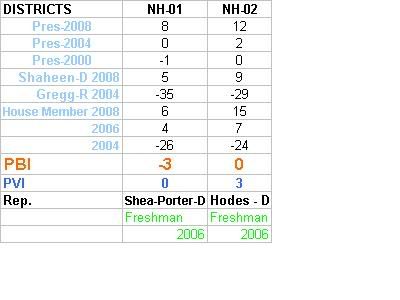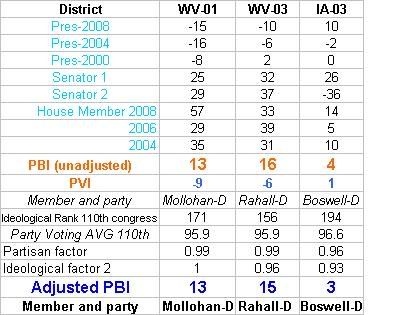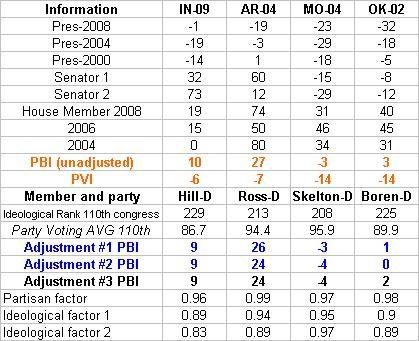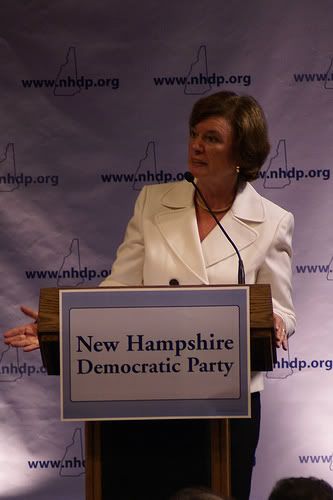Whatever the make-up of the 111th Congress, no one will be able to say that Democrats didn’t try everything in their power to reach a 60-seat majority. As of the spring of 2008, there already were eight highly competitive seats that no one would be surprised to see turn-over: With Virginia and New Mexico all but lost for Republicans (and Senator Ensign acknowledging just as much), the GOP is in grave danger in New Hampshire, Colorado, Alaska, Mississippi, Oregon and Minnesota. On the other hand, Republican attempts to go on the offensive have been disastrous, with only Louisiana looking competitive.
Among these nine initial seats – eight of which are held by Republicans – the rating of four has changed this month. New Mexico has moved from lean Democrat to likely Democrat, Colorado from toss-up to lean Democrat, and Oregon from lean Republican to toss-up. Only Minnesota has moved in the opposite direction, from toss-up to Lean Republican.
9 competitive seats is already a large number – comparable to the field of play two years ago. But with 2008 shaping up to be as good a Democratic year as 2006, the DSCC is aware that it has to do the most of this opportunity and is eager to put even more seats in play. As a result, we have seen a lot of actions since my previous Senate rankings in the second and third-tier of GOP-held seats: In North Carolina, strong polling by Kay Hagan forced Elizabeth Dole to air a round of advertisements, but the DSCC has reserved up to $6 million of air time in the fall. This race is the most likely candidate to join the “initial nine.”
In Maine, Democrats have still not been able to tie Susan Collins to her party label, but the $5 million the DSCC is budgeting for the fall campaign is a huge amount of money for this inexpensive state. In Kentucky, Bruce Lunsford’s primary victory certainly exasperated progressives, but the first slate of polls suggests all hope is not lost for Democrats. As for Texas, Kansas and even Idaho, Democrats would need titanic shifts that for now remain unimaginable, but the mere fact that these races are being discussed is horrendous news for the GOP.
Will Democrats be able to go beyond eight serious targets and seriously contest one of these long-shot races? How close will they come to a sweep of their initial eight targets and will they save Louisiana? These are the obvious questions to ask out of these new rankings and I will be closely monitoring any signs of further shifts in the electoral map. More precise questions that will come to determine the make-up of the next Senate include: Will John Sununu be able to take advantage of McCain’s good name in New Hampshire to appeal to independents? How much will Obama boost black turnout in Louisiana and in Mississippi? Will Al Franken be able to put his personal controversies behind him? And is the Maine electorate already over Bush?
The full new rankings are available here, with this accompanying map:

Outlook: Democratic pick-up a net 5-9 Senate seats.
Prediction: Democrats pick-up a net 7 seats, for a 58-42 majority.
Likely Takeover (2 Republican seats, 0 Democratic seat)
1. Virginia (Open seat; Previous Ranking: 1)
It is hard to believe that Jim Gilmore’s situation has worsened over the past two months given how much of an underdog the former Republican Governor was to start with. It is never a good sign when a presumptive nominee wins his party’s nod with 50.3% of the vote, but that is what happened to Gilmore at his party’s nominating convention. As if this proof of an unenergized conservative base was not enough, the state GOP’s moderate wing is also backing away from Gilmore: incumbent Senator John Warner, the Republican whom Gilmore is seeking to replace, is refusing to endorse his own party’s nominee! The only hope for Republicans to retain this seat is for Barack Obama to tap Mark Warner as his running-mate. Warner might very well have been the favorite in the veepstakes… if he were not favored to win this Senate race.
2. New Mexico (Open; Last ranking: 2 and lean take-over)
Three giants of New Mexico politics entered this race after Senator Domenici announced his retirement back in October. The political career of one of them has already been cut short: Rep. Heather Wilson lost a heated and narrow GOP primary to Rep. Steve Pearce, leaving him in a difficult match-up against Democratic Rep. Tom Udall. Pearce is much more conservative than Wilson, making it more difficult for him to appeal to independents in this blue-leaning year, but Wilson had her own ethical issues.
This is an open seat in a swing-state in a Democratic year — that by itself is a recipe for success Democrats, just as it was in Minnesota in 2006. In a very similar situation, Amy Klochubar opened a large lead against Rep. Kennedy in what was supposed to be a competitive open seat. Now, Udall is leading Pearce by 2:1 in recent polls and has 6 times more cash on hand than his Republican rival. That means Pearce is dependent on the help of the NRSC, help that is unlikely to come. In mid-June, Sen. Ensign, the NRSC chairman, implied that his committee was giving up on the Virginia and New Mexico races. That just about seals the deal in this race.
Lean Takeover (2 R, 0 D)
3. New Hampshire (Incumbent: John Sununu; Last ranking: 3)
The parallels between this race and Pennsylvania’s 2006 Senate race continue. Despite predictions that the race is bound to tighten and that John Sununu is too good a politician to go down without a fight, polls are showing no sign of a competitive race – with the latest numbers finding Shaheen leading by 22%. But Republicans are hoping that the more accurate parallel for the Sununu-Shaheen race will be North Carolina’s 2004 race, when Rep. Burr had stockpiled his cash to launch an ad blitzkrieg starting in September and had turned a consistent deficit into a narrow victory on Election Day. Now, it is Sununu who is saving up for a big push in the fall; as of the end of the second quarter, he has $5 million in the bank versus $2 million for Jeanne Shaheen. Will a late wave of advertisements be enough?
4. Colorado (Open; Last Ranking: 4 and toss-up)
For the first time since the November rankings, Colorado is not rated a “toss-up.” As had been expected from the day the match-up between Mark Udall and Bob Schaffer was set up, the Democrat has pull ahead and is now consistently ahead by 9-10% in recent polls. A combination of factors explains why Udall finally jumped up to his first lead. First, this year’s Democratic bent gives Democrats an edge in any open seat race that should have been tight. Second, Bob Schaffer had a bad few months, in particular over stories broken by the Denver Post about his association with convicted lobbyist Jack Abramoff. Third, Udall fundraising advantage has allowed his campaign to spend more aggressively on ads. Udall outspent Shaffer 3:1 in the second quarter, and the DSCC jumped in with an attack ad of its own.
Meanwhile, we are starting to get a better idea of the campaign arguments Udall and Schaffer will use in the months ahead, and the first debate that opposed the two men in mid-July set some battle lines: Energy is already a hot topic in the campaign, with the two candidates exchanging barbs on the subject and Udall has devoted the entirety of one of his first ads to energy. Schaffer is determined to paint Udall as weak and unable to make much of a decision, while Udall is casting himself as a bipartisan with a commitment to consensus. It does look like Mark Udall is running as more of a moderate than his cousin Tom in New Mexico; beyond his insistence on bipartisanship, Mark voted for the FISA bill and Tom voted against it.
Toss-up (3 R, 1 D)
5. Alaska (Incumbent: Ted Stevens; Last Ranking: 5)
Ted Stevens is suffering from the corruption scandal that has ensnared him and the state’s Republican Party and it is even affecting his fundraising abilities, as Mark Begich outraised the entrenched incumbent in the second quarter. Contrary to Rep. Young in the at-large House race, Stevens does not face a credible primary challenge, a relief for Democrats as the state’s red leaning would kick in to help a Republican not plagued by ethical controversies.
Begich has been at worst tied with Stevens for months now. He went up on TV in early July, with one ad introducing himself and the other devoted to energy issues (with a joint pledge to develop alternative energies and to fight to “open ANWR”). Perhaps boosted by his increased media exposure and his advertisement efforts, Begich has jumped to a 9% lead in the latest poll, though we will naturally need confirmation of that number before drawing any conclusion.
The Democrat’s efforts will be boosted by those of the Obama campaign, which has unexpectedly decided to make Alaska into a battleground state at the presidential level. Alaska polls have shown a tight presidential race, a sharp departure from past cycles in which Bush crushed his opponents by more than 20%. That means that contrary to Knowles in the 2004 Senate race, Begich will not have to swim counter-current and that he might benefit from Obama’s organizational efforts.
6. Mississippi (Incumbent: Roger Wicker; Last Ranking: 8 )
Ronnie Musgrove and Roger Wicker were once roommates, but they are quickly becoming bitter rivals. Polls confirm that the race is a pure toss-up. The Republican incumbent has a clear advantage on the financial front ($3 million of cash on hand versus less than $800K for Musgrove at the end of the second quarter), but the DSCC has already rushed in to help Musgrove respond to Wicker’s ads, demonstrating how seriously it took this contest. The DSCC’s move triggered further controversy: Republicans are charging that the ads break campaign finance rules. Democrats answered by filing their own complaint about Wicker’s fundraising.
It is true that Musgrove would have had a better chance had this special election been held in March, as it should have. Now, Wicker has more time to introduce himself to voters and blunt Musgrove’s high name recognition; the GOP believes November’s turnout will be more uniform than it was in MS-01 in May and that a more conservative electorate will give Wicker victory. But Democrats remain confident: First, there will be no party labels next to the candidates’ names. Second, this is one down-the-ballot race in which the Obama candidacy could have a very clear effect: If there is a significant boost in black turnout, it could prove all Musgrove needs to pick-up this seat. The African-American vote is more than ever the key metric of this senatorial race, and one polls are unlikely to capture accurately.
7. Louisiana (Incumbent: Mary Landrieu; Last Ranking: 6)
Not much has changed in this race since the end of May. For one, Louisiana remains the one credible pick-up opportunity for Republicans, and as such will remain a high priority for the NRSC. Second, the two candidates remain on par financially, with Kennedy keeping up with Landrieu’s fundraising for the second quarter in a row, though the incumbent retains a 2:1 advantage in the cash on hand department. As for polls, they show Landrieu ahead but the race has tightened a bit, with the Democrat ahead mid-single digits and under 50% in a number of recent polls. This is one state in which the presidential race is likely to help the Republican, as Louisiana is not a state Obama will do much of a dent. He might increase black turnout a bit, but the African-American vote’s decrease since Katrina will be an advantage to Kennedy. One strong argument Democrats hold is statements made by Kennedy in 2004 when he was running as a Democrat for Senate.
8. Oregon (Incumbent: Gordon Smith; Last Ranking: 9 and lean retention)
Democrats have targeted Gordon Smith since the very first days of the cycle. But a disappointing recruitment process followed by primary difficulties for Jeff Merkley made Democrats anxious that they could be wasting an opportunity here. Since the May 20th primary, however, Merkley has grown stronger and is consistently polling within a few points of Smith. In fact, Merkley led in a poll for the first time just a few days ago. News that Merkley had outraised Smith in the second quarter hardened his position as a strong challenger.
Smith has been aware of the target he has on his back and has been preparing since the start of the cycle. Despite being distanced in second quarter fundraising, he still has a 8:1 in cash on hand and so much of Merkley’s money was spent in the primary that his campaign is now in financial difficulty. Furthermore, Smith has been rapidly moving to the center, aware that he is at danger of becoming this cycle’s Lincoln Chaffee: a Republican incumbent in a Democratic state who drowns in the blue tsunami, heightened by the probability that Obama scores a large victory in Oregon.
Smith’s solution has been to throw his party label overboard and run as a consensus candidate ready to embrace both side. And he is going very far in that direction. Not only did he run an ad featuring a Democratic state representative and a state Senator endorsing him, but he followed that up with a spot embracing… Barack Obama, in a desperate-seeming effort to show his willingness to work across the aisle. This strategy does not come without risk: Smith, after all, is supporting John McCain and his positioning could confuse voters. And it will make Smith that much more vulnerable to Obama campaigning on Merkley’s side (the Illinois Senator wasted no time issuing a statement reiterating his support for Merkley).
Lean Retention (2 R, 0 D)
9. Minnesota (Incumbent: Norm Coleman; Last Ranking: 7 and toss-up)
This is the first time in six Senate rankings that Minnesota is not rated as a toss-up. After a wild two months in which Al Franken was undermined by a succession of controversies, polls have clearly shifted away from the former comedian. Except for Rasmussen, which continues to show a toss-up race, other pollsters (including SUSA and Quinnipiac) find Coleman leading by double-digits.
Facing a shrewd incumbent with the reputation of a solid campaigner, Franken had no room for error. Yet, his campaign started tanking with revelations of Franken’s tax problems and with the controversy over his 2000 allegedly-pornographic essay in Playboy; this led a Democratic congresswoman state that she was not sure she could support Franken’s campaign and led Planned Parenthood to blast Franken’s “misogynist remarks.” Next came another firestorm over a rape joke Franken helped write on SNL in 1995. Now, the Coleman campaign is airing a personal attack ad blasting Franken for not paying taxes and writing “juicy porn.”
Franken and Coleman’s strategies are clear. The Democrat wants to make this a referendum about the incumbent and about the Republican Party. Franken denounces the “Bush-Coleman recession” and emphasizes Coleman’s proximity to his party’s leadership. The Republican wants to make this a referendum about what he believes is Franken’s polarizing persona. Whoever manages to frame the debate best is likely to win the election – and both candidates have millions of dollars in the bank to define their opponent.
As if all of this agitation was not sufficient, there was the Jesse Ventura question mark. The former Governor only announced he would not run for Senate on July 14th, and his decision was a relief for Franken’s campaign who had far more to lose from a Ventura candidacy. Now, Franken faces trouble within the DFL. Despite some intra-party rumblings back in May, Franken easily won the DFL’s endorsement. Yet, a well-connected attorney recently announced she would run against Franken in the Democratic primary. She is unlikely to threaten Franken’s nomination, but her late run could prevent the former comedian from turning his attention to Coleman.
10. North Carolina (Incumbent: Elizabeth Dole; Last Ranking: 10)
Minnesota concludes the list of the eight obvious Democratic targets. The DSCC has been looking for more seats to contest, and has made a clear choice that North Carolina has the most potential. Chuck Schumer has been including the state in the list of top targets for many weeks now and the DSCC has reserved up air time for up to $6 million in advertising starting mid-September. Think about that number for a minute: Democrats are committing to invest $6 million in their 9th target in a Republican-leaning state in a presidential year. What better sign of confidence could the DSCC send?
Yet, Republicans have reason to feel confident about this race as well. As of my last rankings, a
series of polls had just found Kay Hagan enjoying a stunning post-primary bounce to almost tie Elizabeth Dole. But the Republican incumbent then unleashed a big advertisement campaign. Combined with the fading of Hagan’s primary victory bounce, Dole has recovered a low-double digit lead in all institutes, including SUSA, Rasmussen, PPP and Civitas.
But it is too late for Dole to make herself look strong. She still hovers around the 50% threshold of vulnerability, and the quick drop in her numbers in May shows that her support is weak. And Hagan will benefit from the Obama campaign’s decision to contest North Carolina, particularly since the McCain campaign is doing little to counter. It will help Hagan overcome North Carolina red leaning and it will allow her to rely on Obama’s turnout efforts. North Carolina might look less promising for Democrats than it did late May, but it retains unexpected potential.
Rankings continue here.












 Video:
Video:  Carol then took to the mic:
Carol then took to the mic:


 Carol then saved the best for last after wishing Mike Lopez a Happy Birthday and thanking Jim Craig (“one class act”) for emceeing the event. When talking about the importance of sending Bob Bruce to the governor’s counsel she says:
Carol then saved the best for last after wishing Mike Lopez a Happy Birthday and thanking Jim Craig (“one class act”) for emceeing the event. When talking about the importance of sending Bob Bruce to the governor’s counsel she says:
 To donate to Carol’s re-election campaign
To donate to Carol’s re-election campaign 